draw a 3d deck in autocad 2013
Affiliate 1. Introduction to 3D Design
Welcome to the fantastic globe of 3D! AutoCAD is an first-class software for creating 2d projects in all technical areas, only instead of 2nd representation, isn't it much better if we could create authentic 3D models, view them from all perspectives (even from within), and get 2D drawings easily? With AutoCAD we can!
The topics covered in this chapter are as follows:
-
The importance of the third coordinate
-
How to choose and manage 3D workspaces
-
Why object properties are cardinal in 3D
-
How auxiliary tools (osnap, ortho, and others) tin can ease the piece of work in 3D
-
2d commands in a 3D world
-
How to use linear 3D commands
-
How to create swell 3D models
The Z coordinate
3D is all virtually the third Z coordinate. In 2nd, we simply intendance for the Ten and Y axes, only never used the Z centrality. And most of the fourth dimension, we don't even use coordinates, just the pinnacle-xx AutoCAD commands, the Ortho tool, and then on. Merely in 3D, the correct use of coordinates tin essentially advance our work. We volition first briefly cover how to introduce points by coordinates and how to extrapolate to the third dimension.
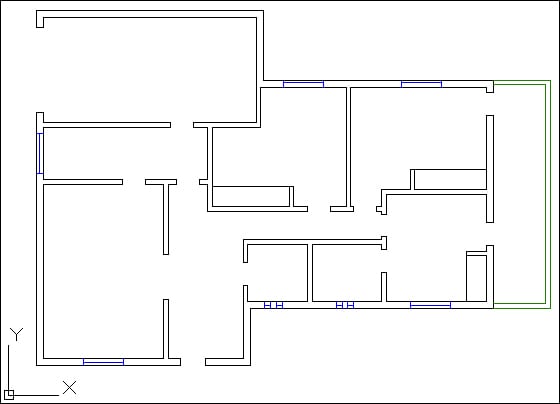
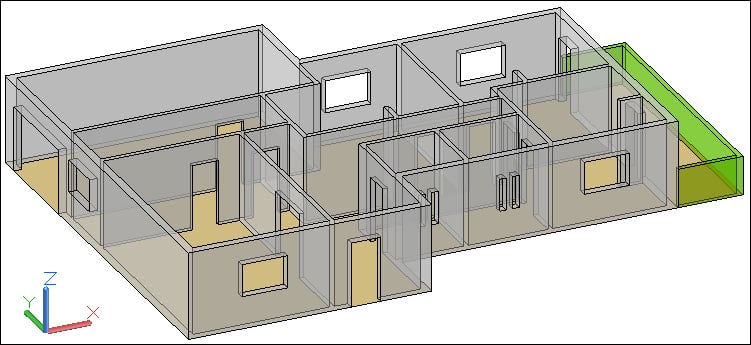
Accented coordinates
The location of all entities in AutoCAD is related to a coordinate system. Whatever coordinate system is characterized by an origin and positive directions for the X and Y axes. The Z axis is obtained directly from the X and Y axes by the correct-paw dominion: if nosotros rotate the correct hand from the X axis to the Y centrality, the pollex indicates the positive Z direction.
Picture that when prompting for a bespeak; besides specifying information technology in the drawing area with a pointing device such as a mouse, nosotros can enter coordinates using the keyboard.
The format for the absolute Cartesian coordinates related to the origin is divers past the values of the three orthogonal coordinates, namely, X, Y, and Z, separated by commas:
X coordinate, Y coordinate, Z coordinate
The Z coordinate can be omitted.
For instance, if we define a point with the accented coordinates 30, xx, and 10, this means 30 accented is in the X direction, 20 is in the Y management, and 10 is in the Z direction.
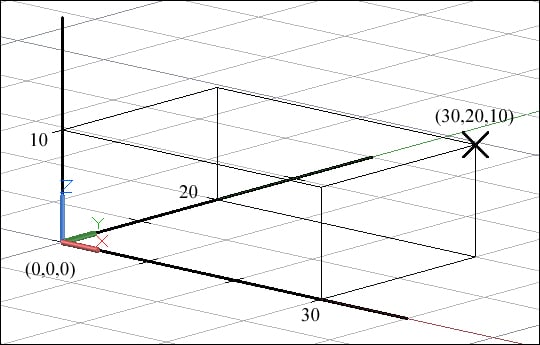
Relative coordinates
Frequently, we want to specify a point in the coordinates, but one that is related to the previous signal. The format for the relative Cartesian coordinates is defined past the symbol AT ( @ ), followed by increment values in the three directions, separated by commas:
@Ten increase, Y increment, Z increase
Of course, one or more increments can be 0. The Z increment tin can exist omitted.
For instance, if we ascertain a point with relative coordinates, @0,20,10, this means in relation to the previous point, 0 is in 10, 20 is in Y, and 10 is in Z directions.
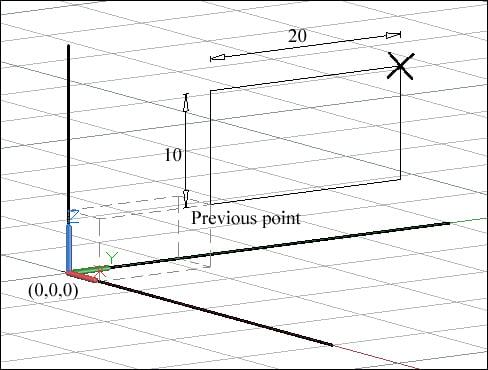
Point filters
When we want to specify a signal merely decompose it step-by-pace, that is, separate its coordinates based on different locations, we may use filters. When prompting for a point, we admission filters by digitizing the X, Y, or Z axes for individual coordinates, or XY, YZ, or ZX for pairs of coordinates. Some other fashion is from the osnap menu, CTRL + mouse right-click, and then Signal Filters . AutoCAD requests for the remaining coordinates until the completion of point definition.
Imagine that we want to specify a betoken, for instance, the center of a circle, where its 10 coordinate is given past the midpoint of an edge, its y coordinate is the midpoint of another edge, and finally its Z coordinate is any betoken on a elevation face up. Assuming that Midpoint osnap is predefined, the dialog should be:
Command: Circumvolve Specify heart betoken for circle or [3P/2P/Ttr (tan tan radius)]: .X of midpoint of edge (need YZ): .Y of midpoint of border (demand Z): any point on superlative face Specify radius of circle or [Diameter]: value
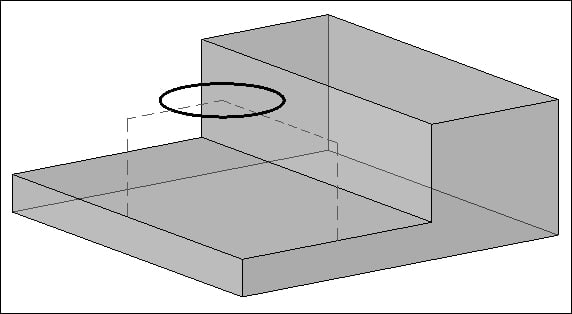
Workspaces
AutoCAD comes with several workspaces. It's upward to each of us to choose a workspace based on a classic surround or the ribbon. To change workspaces, we tin can pick the workspace switching push on the status bar:
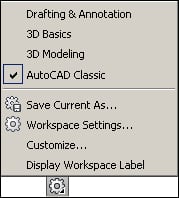
There are other processes for acceding this control such as the workspaces list on the Quick Access Toolbar (title bar), the Workspaces toolbar, or by digitizing WSCURRENT, but the admission shown is consequent among all versions and always bachelor.
Classic environment
The archetype environment is based on the toolbars and the card bar and doesn't use the ribbon. AutoCAD comes with AutoCAD Archetype workspace, simply it'due south very elementary to adapt and view the suitable toolbars for 3D.
The advantages of using this environment are speed and consistency. To bear witness another toolbar, we right-click over any toolbar and cull it. Typically, we want to accept the following toolbars visible also Standard and Layers: Layers Ii, Modeling, Solid Editing, and Render:

Ribbon surroundings
Since the 2009 version, AutoCAD also allows for a ribbon-based environment. Normally, this surroundings uses neither toolbars nor the card bar. AutoCAD comes with two ribbon workspaces, namely, 3D Basics and 3D Modeling; the offset being less useful than the second.
The advantages are that we take consistency with other software, commands are divided into panels and tabs, the ribbon can exist collapsed to a single line, and it includes some commands non available on the toolbars. The disadvantage is that as it'southward a dynamic environment, we oft accept to activate other panels to access commands and some of import commands and functions are not e'er visible:

Notation
When modeling in 3D, the layers list visibility is almost mandatory. We may add this list to the Quick Admission Toolbar by applying the CUI command or by right-clicking to a higher place the control icon we want to add together. Another way is to pull the Layers panel to the drawing area, thus making it permanently visible.
Layers, transparency, and other properties
When we are modeling in AutoCAD, the power to command object properties is essential. After some hours spent on a new 3D model, nosotros can take hundreds of objects that overlap and obscure the model's visibility. Here are the most important properties.
Layers
If a correct layers application is cardinal in second, in 3D it assumes farthermost importance. Each blazon of 3D object should be in a proper layer, thus allowing us to control its backdrop:
-
Name : A good piece of advice is to not mix 2D with 3D objects in the same layers. So, layers for 3D objects must be hands identified, for instance, by adding a 3D prefix.
-
Freeze/Thaw : In 3D, the density of screen data can exist huge. And then freezing and unfreezing layers is a permanent procedure. It's better to freeze the layers than to turn off because objects on frozen layers are not processed (for instance, regenerating or counting for
ZOOMExtents ), thus accelerating the 3D process. -
Lock/Unlock : Information technology's quite annoying to observe that at an advanced phase of our project, our walls moved and caused several errors. If we demand that information visible, the best way to avert these errors is to lock layers.
-
Colour : A proficient and logical color palette assigned to our layers tin improve our understanding while modeling.
-
Transparency : If we want to see through walls or other objects at the creation process, nosotros may give a value betwixt 0 and 90 per centum to the layers transparency.
Last but non least, the best and the easiest procedure to assign rendering materials to objects is by layer, and then another good point is to apply a right and detailed layer scheme.
Transparency
Transparency, every bit a belongings for layers or for objects, has been available since Version 2011. Besides its utility for layers, it tin can likewise be applied directly to objects. For instance, nosotros may have a layer chosen 3D-SLAB and just want to see through the upper slab. Nosotros can change the objects' transparency with PROPERTIES ( Ctrl + 1 ).
To see transparencies in the drawing area, the TPY push button (on the status bar) must be on.
Visibility
Some other contempo improvement in AutoCAD is the power to hide or to isolate objects without changing layer properties.
We select the objects to hide or to isolate (all objects not selected are hidden) and correct-click on them. On the cursor menu, we choose Isolate and then:
-
Isolate Objects : All objects non selected are invisible, using the
ISOLATEOBJECTScommand -
Hide Objects : The selected objects are invisible, using the
HIDEOBJECTScommand -
End Object Isolation : All objects are turned on, using the
UNISOLATEOBJECTScommand.
At that place is a modest lamp icon on the status bar, the second icon from the correct. If the lamp is crimson, it ways that there are hidden objects; if it is yellow, all objects are visible:
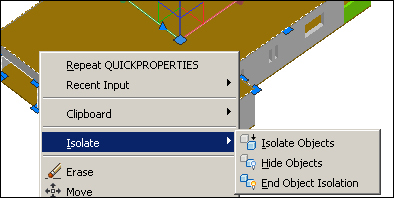
Shown on the post-obit image is the application of transparency and hide objects to the left wall and the upper slab:

Auxiliary tools
AutoCAD software is very precise and the correct application of these auxiliary tools is a key factor for good projects. All users should be familiar with at to the lowest degree Ortho and Osnap tools. Post-obit is the application of auxiliary tools in 3D projects complemented with the first exercise.
OSNAP, ORTHO, POLAR, and OTRACK auxiliary tools
Let's start with object snapping, probably the nearly frequently used tool for precision. Every time AutoCAD prompts for a point, nosotros can access predefined object snaps (also known as osnaps) if the OSNAP button on the condition bar is on. To modify it, we only have to click on the OSNAP button or press F3 . If we desire an private osnap, we can, among other ways, digitize the first three letters (for example, MID for midpoint) or utilize the osnap carte du jour ( CTRL + right-click). Osnaps work everywhere in 3D (which is cracking) and is particularly useful is the Extension osnap style, which allows you to specify a point with a distance in the direction of any edge.
But what if we want to specify the projection of 3D points onto the working XY plane? Easy! If the OSNAPZ variable is prepare to 1, all specified points are projected onto the plane. This variable is not saved and 0 is assigned as the initial value.
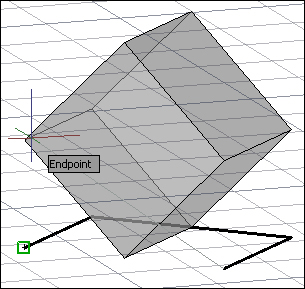
More than corking news is that ORTHO ( F8 ) and POLAR ( F10 ) work in 3D. That is, we tin specify points by directing the cursor forth the Z axis and assign distances. Lots of @ spared, no?
OTRACK ( F11 ), used to derive points from predefined osnaps, also works along the Z-centrality direction. We suspension over an osnap and can assign a distance along a specific direction or just obtain a crossing:
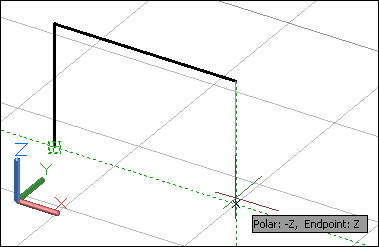
3DOsnap tool
Starting with Version 2011, AutoCAD allows you lot to specify 3D object snaps. Besides, here we tin can access predefined 3D osnaps keeping 3DOSNAP ( F4 ) on, or we can access them individually. At that place are osnaps for vertices, midpoints on edges, centers of faces, knots (spline points), points perpendicular to faces, and points nearest to faces.
Practice 1.ane
Using the LINE command, coordinates, and auxiliary tools, let'due south create a cabinet skeleton. All dimensions are in meters and we outset from the lower-left corner. The ORTHO or POLAR button must be on and the OTRACK and OSNAP buttons with Endpoint and Midpoint predefined.
Note
Equally in 2D, rotating the cycle mouse forrard, we zoom in; rotating the bicycle backward, we zoom out; all related to cursor position. To automatically orbit around the model, nosotros concur downward SHIFT and the cycle simultaneously. The cursor changes to two small ellipses and then we elevate the mouse to orbit around the model. Visualization is the field of study of the side by side affiliate.
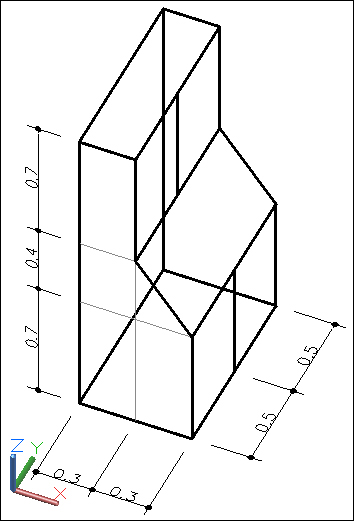
-
We run the
LINEcommand at any point, block direction 10 ( POLAR or ORTHO ) and assign the distance:Command: LINE Specify outset signal: any point Specify next point or [Undo]: 0.6
-
We cake the Z direction and assign the distance:
Specify adjacent signal or [Disengage]: 0.7 -
The best way to specify this point is with relative coordinates:
Specify next point or [Close/Disengage]: @-0.3,0,0.iv -
We cake the Z direction and assign the distance:
Specify next point or [Shut/Undo]: 0.seven -
The best way to close the left polygon is to pause over the commencement point, motility the cursor up to find the crossing, with Polar or Ortho coming from the concluding point, and utilize Close option to close the polygon:
Specify next point or [Close/Disengage]: signal with OTRACK Specify next betoken or [Shut/Undo]: C
-
We re-create all lines 1 meter in the Y direction:
Command: COPY Select objects: Specify opposite corner: six plant Select objects: Enter Current settings: Re-create style = Multiple Specify base bespeak or [Deportation/manner] <Deportation>: bespeak Specify second signal or [Array] <use start indicate as displacement>: 1 Specify 2d point or [Assortment/Exit/Undo] <Exit>: Enter
-
We consummate the cabinet skeleton by drawing lines between endpoints and midpoints:
Application of 2D commands
Tin those everyday commands be used in 3D? Of class they can! We have already seen the LINE command, layers, and other properties. Permit's see some particularities and 3D applications and learn that a whole bunch of known commands tin besides be applied.
Cartoon commands
Basically, all drawing commands can be used in 3D, provided that we have the right working plane, LINE being the exception.
The LINE command can take its endpoints anywhere, so information technology's a real 3D command. But circles, arcs, and polylines (including polygons and rectangles) are drawn on the working plane (called active coordinate system) or a plane parallel to the working plane.
Editing commands
Hither is the listing of the most important editing commands that work the same way in 2D or 3D: ERASE, Motility, Re-create, SCALE, Join, EXPLODE, and Intermission.
Some commands work just on the objects plane, not necessary the agile working airplane. Examples are FILLET, CHAMFER, and First.
There are as well some that piece of work simply in relation to the active working aeroplane such every bit MIRROR, ARRAYCLASSIC (Assortment earlier version 2012), and ROTATE.
Side by side are editing commands that accept special 3D features:
-
TRIMandEXTEND: Both commands have an option, Projection , which specifies if linear objects are cutting or extended to the boundaries related to the current coordinate system or the current view. This allows for cutting or extending objects that, in the electric current view, seems to be on the aforementioned aeroplane, simply are actually on dissimilar planes. -
Assortment: This control inverse a lot in version 2012. Now, nosotros have three different commands for rectangular, polar, and path arrays. Among multiple options, in that location are ii with special importance for 3D: Rows , where nosotros tin define a number of rows with a height distance, and Levels also with a variation in height.
Other entities and commands
No one can employ AutoCAD without inquiring for information from time-to-time. The DIST command allows y'all to obtain the 3D distance, and also increments in X, Y, and Z directions, between two points. Another of import command is ID (or from the Tools menu bar, Enquiry | ID Point ), for inquiring about the absolute coordinates of points.
Blocks work exactly the same way in 2nd or 3D. When inserting a block with not-uniform scale, we can specify a unlike scale for the Z direction.
Regions are 2d opaque closed objects that are frequently used in 3D. As well 3D, they tin can be very useful for extracting areas, inertia moments, and other geometric properties.
To create regions, we must have their contours already fatigued. Contours can be lines, arcs, circles, ellipses, elliptical arcs, and splines. In 2nd, regions are created with two commands:
-
REGION: This command (aliasREG) creates regions from airtight objects or sets of linear objects that define a airtight boundary. It only prompts for the selection of objects and the original objects by default are deleted. -
Purlieus: This great command (aliasBO) allows for the easy creation of closed polylines or regions by specifying internal points to closed boundaries. An example follows.
Exercise 1.2
We are going to create some 2D objects and from them, some regions.
-
Starting time AutoCAD and create some 2d linear objects, similar to those shown in the following image. For now, dimensions are non important.

-
Create a new layer chosen
REGIONS, assign a unlike colour to it, and activate it. -
Run the
BOUNDARYcommand (or useBOalias). On the dialog box shown in Object type listing, cull Region . Select the Pick Points push button. The dialog box disappears. -
Specify the iv points inside the closed surface area, shown on the image and press Enter . The four regions are created. Freeze layer 0 to view but the regions.
-
Regions are opaque. To check, utilize the
VSCURRENT(VS) command (explained in the next affiliate). Choose the Realistic option:
-
Use the
VSCURRENTcommand again and cull the 2dwireframe option to come back to normal. -
Nosotros don't demand to save this drawing.
Linear 3D entities
We can apply thickness to virtually linear 2nd entities and also create linear 3D entities like 3D polylines and splines.
Thickness
Almost all linear entities that we know from 2D take a property called Thickness, whose value represents a height along the Z axis (a better discussion actually should exist top). This is the only 3D characteristic bachelor in AutoCAD LT and can be applied to text (if made with a text style that uses an SHX font), just across that is quite limited.
The best style to alter the value of thickness is with the PROPERTIES command, Ctrl + 1 . A line is still a line or a text notwithstanding text, but with a proper visualization, these entities tin can transmit a 3D feeling:
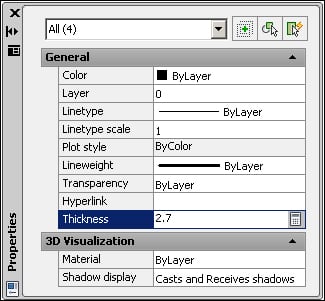

3D polylines
Polylines created with the PLINE command are 2D, non assuasive for vertices with dissimilar Z coordinates. These polylines are designed by lightweight polylines. But what if a single object is needed to be composed by segments whose endpoints have different Z coordinates?
The answer is to create 3D polylines. 3 processes are available:
-
3DPOLY: This control (alias3P) creates 3D polylines from the kickoff. It works similar theLINEcontrol, only the result is a single object. -
JOIN: This control (aliasJ) creates 3D polylines from a contiguous sequence of lines with shared endpoints. Information technology is enough that one endpoint of a line is out of the airplane for a 3D polyline to be created. -
PEDIT: The aforementioned command (aliasPE) used for the cosmos of second polylines from lines and arcs tin also be practical to join lines to a 3D polyline. The start object must already be a 3D polyline.
Note
Starting with version 2012, the best way to utilize the Join command is to select all the line segments at the kickoff command prompt, without specifying a source object. Depending on the type of selected objects and their positions, the almost suitable object is automatically created.
And in what situations may we have utility for 3D polylines?
3D polylines are particularly useful to mensurate objects that develop in different directions, such as pipage or wiring, and to ascertain paths for other 3D objects such equally piping. The cosmos of 3D solids and surfaces from linear objects is the subject of Chapter 4, Creating Solids and Surfaces from 2nd .
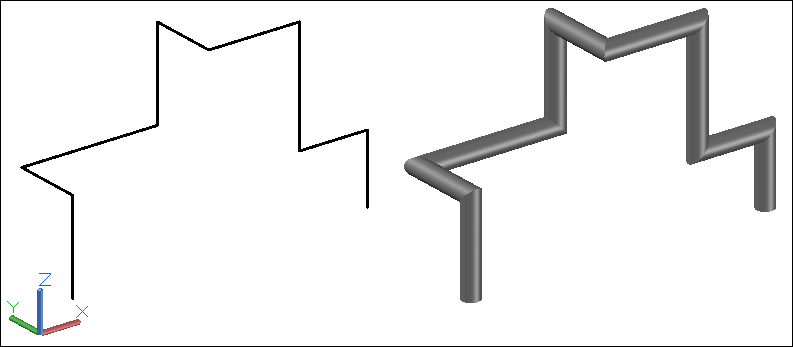
Splines and helixes
Splines are smooth linear objects, normally without corners that laissez passer through or near specified points. Spline is short for Nonuniform Rational B-Spline ( NURBS ). Splines are described past a set of parametric mathematical equations, but have no fright, for AutoCAD will internally deal with this, we will not accept to!
Splines are used whenever nosotros need smooth curves and are also the foundation for NURBS surfaces, the most used surfaces in the automotive or aeronautic projects.
To create a spline nosotros apply the (guess?) SPLINE command (alias SPL). Past default, the command only prompts for the location of fit points, and the spline passes through the specified points. An Enter finishes the spline and the Close choice creates a closed spline.
We can control splines by two sets of vertices:
-
Fit points: These are the points used to create the spline -
Control vertices: These are the points that define the spline
When selected, the small blueish triangle allows switching betwixt Fit points and Control vertices. To edit a spline is very uncomplicated: we select it, without command, and work with grips. Nosotros can either click a grip and move it, or we tin can place the cursor over a grip and on the grip bill of fare choose to move the vertex, add one, or remove that vertex. This terminal process is known as multifunctional grip.

Note
Since AutoCAD 2012, the JOIN command is besides a groovy tool for the cosmos of circuitous splines. We may have a contiguous and non-planar sequence of lines, arcs, elliptical arcs, splines that the outcome is a single spline.
With the HELIX control we can create 2D or 3D helixes or spirals. By default, the command prompts for the eye point of the base, base of operations radius, tiptop radius, and height. As options, we accept the position of the centrality endpoint, the number of turns, the superlative of one complete turn, and the twist (if the helix is drawn in the clockwise or the counterclockwise direction). To edit a helix object, we tin can utilize grips or the PROPERTIES command.
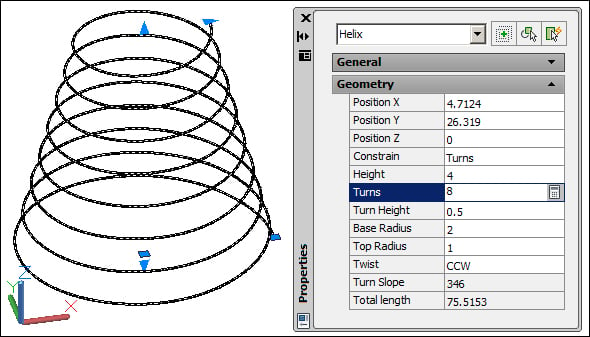
If we explode a helix object, the result is a spline. The Blend command, new in Version 2012, creates a special spline that connects 2 open linear objects. The command only prompts for the selection of the first curve and the choice of the second bend. Selections must be virtually the endpoints to connect. The Continuity option allows for the choice of the practical type of continuity: Tangent with a tangency continuity (known equally G1 continuity), or Polish with a curvature continuity (known as G2).
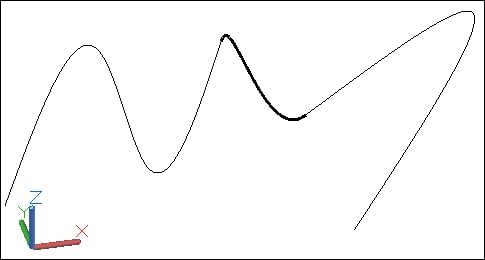
How to create slap-up 3D models
There are several possibilities for starting a 3D project. We may:
-
Create a 3D project from a complete set of second drawings, with all the necessary views included. Here, we don't have to projection or idealize; nosotros just have to decide the best approach and the commands that are to be used.
-
Create a 3D project from a plant view and another elements. Here nosotros have to project a lot and probably have to written report several possibilities in club to find the most suitable projection.
-
Create a 3D project from scratch. We have nothing except some conditions near space, functionality, or others.
For any of these possibilities, the keyword is planning.
First, we take to carefully plan the work. Instead of immediately starting to model, it's better and less fourth dimension-consuming to decide a typhoon sequence of tasks.
Some important questions at this phase:
-
Do I accept admission to something similar?
-
How complex will my project be?
-
Do I have some 3D blocks that I may use?
-
Have I created the needed layers and other definitions (layouts, styles, and so on) in another projection?
-
Am I going to utilize external references in my project?
-
Do I have all the necessary data?
If we have 2D drawings, these must be carefully studied, especially if there are any inconsistencies betwixt views and how to start.
Next, we prepare our model. We can open the nearly important second drawing and save it with a dissimilar name; we tin can get-go a cartoon and insert the other drawings as blocks or external references. We must verify if units are coherent, past applying the UNITS control.
Continuing prepare upwards, we create layers and other definitions. A winning command here is ADCENTER, also known equally Design Center ( Ctrl + 2 ) that allows for gathering all layers, blocks, and other definitions from other drawings without opening them.
If we pretend to make some prissy realistic images (rendering), we must exist careful with layers, knowing that the easiest way to assign materials is by layer.
Should we start from floor plans or elevations? Well, it depends on the projection. Nosotros can model from plans, just some parts may come up from other views and then exist positioned.
A final piece of advice is to go along several versions of your project. When an important step is accomplished, we must relieve a fill-in copy. If nosotros alter our listen about a stride or if the electric current file is corrupted, we minimize the losses.
Summary
In this affiliate, we were introduced to 3D. We saw the importance of the third coordinate, how to enter points in absolute or relative coordinates, and the application of point filters. Nosotros analyzed workspaces and how to command the AutoCAD surroundings. The importance of layers, transparency, and other properties were then explained. Auxiliary tools were then covered before nosotros looked at how to employ them to ease the 3D project. Nosotros so saw the awarding of those commands in 3D used daily and some that are particularly important, such equally Boundary. Nosotros likewise covered the linear 3D commands and the Thickness belongings. We concluded the chapter past covering skilful practices when modeling in 3D.
Source: https://www.packtpub.com/hardware-and-creative/autodesk-autocad-2013-practical-3d-drafting-and-design
0 Response to "draw a 3d deck in autocad 2013"
Postar um comentário